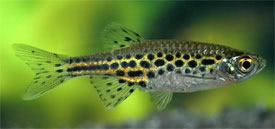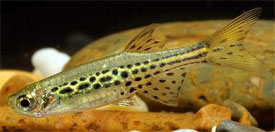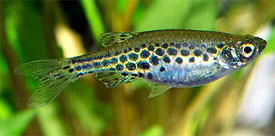
 Magyarul / Hungarian
Magyarul / Hungarian



- Scientific name: Brachydanio tinwini
- Synonyms: Danio tinwini, Danio sp. 'Myanmar', Danio sp. 'Burma', Danio sp. 'TW02'
- Common name: Gold Ring Danio
- Group: Cyprinids
- Habitat: Asia; North Myanmar (Burma)
- Size: 2-3 cm
- Biotope: Found in slower-moving, marginal sections of well-oxygenated streams and small rivers.
- Social behavior: A peaceful and active shoaling fish, ideal for community tanks. In larger groups (15-20 fish) they become bolder, and males will also display their best colors as they compete with each other.
- Diet: Omnivorous; in nature they eat small invertebrates and their larvae. In the aquarium they accept everything: live, frozen and flake foods too.
- Breeding: Quite easy
- Tank: Minimum 30 litres
- Population: 5-6 fish for 40 litres
- Decoration: They deserve a heavily-planted tank. Use dark gravel substrate with some larger smooth rocks. The tank must be covered, as they are excellent jumpers. Water movement shouldn’t be too strong.
- Temperature: 20-26 °C
- pH: 6.5-7.5
- Hardness: 1-5 NK°
- Lifespan: 2-3 years
Description: The fish has been named after the collector and exporter U Tin Win from Myanmar. The fish has a golden body covered with bluish-black spots. It is similar to Danio kyathit and Danio nigrofasciatus but can be told apart by its smaller size, spotted patterning in the unpaired fins and much shorter barbels.
Mature females are a little larger and plumper. It is more obvious during spawning, when the female fills with eggs, and the male intensifies its color. Like many small cyprinids, Gold Ring Danio is an egg-scatterer spawner, with no parental care. Well-fed fish will usually spawn, and it is possible that a small numbers of fry survive in the community tank. They can be bred in a small (12-15 litres), dimly lighted tank, that filled with Java moss. Water should be very soft, of slightly acidic. The female will scatter the not too adhesive eggs among the plants, and they will fall to the substrate. The major problem usually is to prevent the adults from eating the eggs or the fry.











